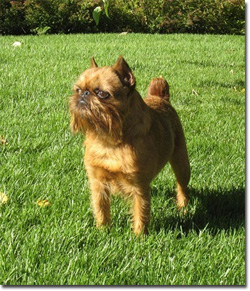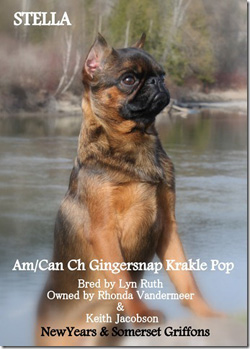
Brussels Griffon
Group: Toy Group
Origin: Belgium
Weight:
- The “small” class dogs and bitches should not exceed 7 lbs (3 kg).
- The “large” class dogs and bitches weigh more than 7 lbs (3 kg) but should not exceed 12 lbs (5.5 kg).
Other Names: Griffon Bruxellois

Rough-coated Brussels Griffon
Am/Can Ch Gingersnap Jamaican Me Crazy
Owned by Rhonda Vandermeer
Photo: New Years & Somerset Griffons
CLICK HERE to View Breeder Listings
Breed Profile
The Brussels Griffon breed, native to Belgium, is believed to be the result of crossing a variety of Toy breeds in the early 19th century, including Affenpinscher-type dogs, the Pug and the English Toy Spaniel.
In appearance, the Griffon has a flat face, prominent chin and large wide-set eyes. He has a square and sturdy body and comes in one of two coat types: either harsh and wiry or smooth and tight. Both types are reddish brown, black and reddish brown, black with red-brown markings, or solid black.
He is very intelligent, alert, sensitive, and curious. He was bred to be the ultimate companion and is extremely devoted to his family, affectionate and adaptable. Despite his small size, his spirited nature makes him a very alert watchdog. Aggressive behaviour towards him can result in his responding by trying to defend himself.
Health Issues
If you are considering the adoption of a Brussels Griffon puppy, or any breed, it is very important to be selective in choosing a responsible and reputable breeder. Ensure that the prospective puppy’s parents have all health clearances. Breeding of any dog should not be done until after they have been proven to be free of evidence of significant hereditary diseases. (For more information on selecting a breeder, see the articles on the General Information page.)
Recommended Health Screening:
The National Brussels Griffon Club recommends that breeding stock be screened and certified free from hereditary eye defects, patella luxation and hip dysplasia.
For the Brussels Griffon, the CHICNote 1 database includes health screenings for:
- Eye Examination by a board Ophthalmologist
- Patellar Luxation
- Also listed as optional: Hip Dysplasia, Autoimmune Thyroiditis, Progressive Retinal Atrophy, and Syringomyelia – Recomemnd MRI (Magnetic Resonance Imaging) – no database registration.
Additional Health Resources:
- Canine Health Information Center (CHIC) — Providing a source of health information for owners, breeders, and scientists that will assist in breeding healthy dogs. CHIC is a centralized canine health database jointly sponsored by the AKC/Canine Health Foundation (AKC/CHF) and the Orthopedic Foundation for Animals (OFA).
- Health and Nutrition — Growing section of the Canada’s Guide to Dogs website which includes information on several health and nutrition related issues.
- AKC Canine Health Foundation — Working towards developing scientific advances in canine health.
- OFA – Companion Animal Eye Registry (CAER)
- Orthopedic Foundation for Animals (OFA)
- Ontario Veterinary College (OVC)
- University of Pennsylvania Hip Improvement Program (PennHip)
- HealthGene — HealthGene Corporation is the leading provider of veterinary DNA diagnostic services in Canada.
- Labgenvet — Laboratory of Veterinary Genetics is a Canadian diagnostic laboratory that offers a comprehensive service of DNA tests for veterinary genetic diseases.

Photo: New Years & Somerset Griffons
Grooming Information
The Brussels Griffon comes in two coat types — the rough and the smooth. The smooth coated dog should be brushed regularly and during seasonal shedding, more frequent brushing and baths are recommended. The rough coated dog does not shed and requires clipping about every three months. Regular grooming and daily brushing also helps remove the dead hairs. For conformation showing, the rough coated Griffon is hand stripped.
- Grooming — This section of the Canada’s Guide to Dogs website includes tips, articles and information covering all aspects of dog grooming along with a listing of Groomers from across Canada.
Training Resources
The Griffon is known as a breed who can be difficult to housetrain. He is, however, very easily trained in obedience provided that proper training methods are used. The breed is very intelligent but sensitive and, like many breeds, responds best to positive training methods using praise, treats, consistency and patience.
- Toy Breeds — Housebreaking
- Training — For training information, see this growing section of the Canada’s Guide to Dogs website for tips, articles, as well as listings of training centres across Canada.
Additional Information
- 10 Things to Consider Before Getting a Dog
- Toy Breeds—Selecting the Perfect Pooch
- Clubs, Sports & Activities — For information on the many sports and activities you can get involved in with your dog.
- Working Dogs — The Working Dogs section of the Canada’s Guide to Dogs website provides information and listings of organizations that are involved in various dog jobs, such as Guide Dogs, Therapy Dogs, Police Dogs, Protection Dogs, and much more.
*NOTE 1: CHIC – The Canine Health Information Center “is a database of consolidated health screening results from multiple sources. Co-sponsored by the Orthopedic Foundation for Animals (OFA) and the American Kennel Club (AKC) Canine Health Foundation, CHIC works with parent clubs to identify health screening protocols appropriate for individual breeds. Dogs tested in accordance with the parent club established requirements, that have their results registered and made available in the public domain are issued CHIC numbers.” To learn more, visit: www.caninehealthinfo.org
*NOTE 2: The Fédération Cynologique International (FCI) is the World Canine Organization, which includes 91 members and contract partners (one member per country) that each issue their own pedigrees and train their own judges. The FCI recognizes 344 breeds, with each being the “property” of a specific country. The “owner” countries write the standards of these breeds in co-operation with the Standards and Scientific Commissions of the FCI, and the translation and updating are carried out by the FCI. The FCI is not a breed registry nor does it issue pedigrees.
Breed Listing
Quick Links
Get In Touch
- Email: canadasguidetodogs@gmail.com
- Email: info@canadasguidetodogs.com
- Visit us on Facebook: www.facebook.com/CanadasGuideToDogs
— CanadasGuideToDogs.com is an Amazon Associate as well as a participant in various affiliate programs, as such fees are earned from qualifying purchases.
